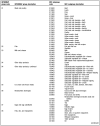Dietary sources of sodium in China, Japan, the United Kingdom, and the United States, women and men aged 40 to 59 years: the INTERMAP study
- PMID: 20430135
- PMCID: PMC4308093
- DOI: 10.1016/j.jada.2010.02.007
Dietary sources of sodium in China, Japan, the United Kingdom, and the United States, women and men aged 40 to 59 years: the INTERMAP study
Abstract
Public health campaigns in several countries encourage population-wide reduced sodium (salt) intake, but excessive intake remains a major problem. Excessive sodium intake is independently related to adverse blood pressure and is a key factor in the epidemic of prehypertension/hypertension. Identification of food sources of sodium in modern diets is critical to effective reduction of sodium intake worldwide. We used data from the INTERMAP Study to define major food sources of sodium in diverse East Asian and Western population samples. INTERMAP is an international, cross-sectional, epidemiologic study of 4, 680 individuals ages 40 to 59 years from Japan (four samples), People's Republic of China (three rural samples), the United Kingdom (two samples), and the United States (eight samples); four in-depth, multipass 24-hour dietary recalls/person were used to identify foods accounting for most dietary sodium intake. In the People's Republic of China sample, most (76%) dietary sodium was from salt added in home cooking, about 50% less in southern than northern samples. In Japan, most (63%) dietary sodium came from soy sauce (20%), commercially processed fish/seafood (15%), salted soups (15%), and preserved vegetables (13%). Processed foods, including breads/cereals/grains, contributed heavily to sodium intake in the United Kingdom (95%) and the United States (for methodological reasons, underestimated at 71%). To prevent and control prehypertension/hypertension and improve health, efforts to remove excess sodium from diets in rural China should focus on reducing salt in home cooking. To avoid excess sodium intake in Japan, the United Kingdom, and the United States, salt must be reduced in commercially processed foods.
Copyright 2010 American Dietetic Association. Published by Elsevier Inc. All rights reserved.
Figures
References
-
- Stamler J, Stamler R, Neaton JD. Blood pressure, systolic and diastolic, and cardiovascular risks: US population data. Arch Intern Med. 1993;153:598–615. - PubMed
-
- Stamler J. The INTERSALT study: Background, methods, findings, and implications. Am J Clin Nutr. 1997;65:626S–642S. suppl. - PubMed
-
- Sasaki S, Zhang XH, Kesteloot H. Dietary sodium, potassium, saturated fat, alcohol, and stroke mortality. Stroke. 1995;26:783–789. - PubMed
-
- Khaw KT, Barrett-Connor E. The association between blood pressure, age, and dietary sodium and potassium: A population study. Circulation. 1988;77:53–61. - PubMed
-
- Perry IJ, Beevers DG. Salt intake and stroke: A possible direct effect. J Hum Hypertens. 1992;6:23–25. - PubMed
Publication types
MeSH terms
Substances
Grants and funding
LinkOut - more resources
Full Text Sources
Medical


